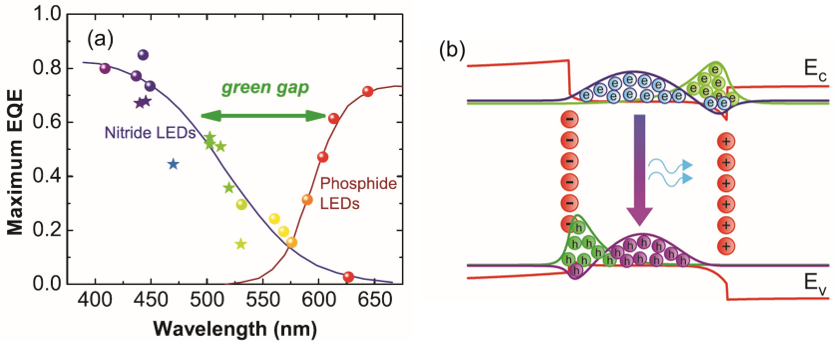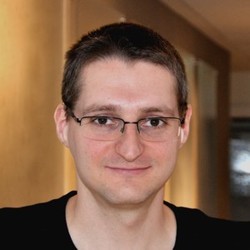Project SONATA
„Circumvention of piezoelectric fields in III-nitride heterostructures – a way towards solving the green gap problem”
Project Description
The light emitting diodes (LEDs) based on III-nitrides are used in an increasing number of applications. The biggest one is the general lighting. General lighting is responsible for 15% of global electricity consumption. US Department of Energy forecasts that the savings in energy consumption by 2030, thanks to use of III-nitride LED, will be roughly 260 TWh annually. This will reduce the consumption of fossil fuels and generation of air pollution and greenhouse gasses. These enormous savings come from the exceptionally high efficiency of InGaN LEDs in violet and blue colors and have been the reason for awarding the Nobel Prize in Physics in 2014 to the inventors of white LEDs – Prof Shuji Nakamura, Prof Isamu Akasaki and Prof Hiroshi Amano. Any increase in the efficiency of InGaN will reduce the electricity consumption spend for general lighting even further. However, the biggest advantage might come from the improvement of efficiency of green LEDs. Today, the white light, emitted by LEDs, is generated by mixing the violet (or blue) light from InGaN and yellow light from phosphorous, which is excited by the light originating from InGaN. The conversion from violet (or blue) light to yellow is associated with a loss in energy. A different kind of approach is mixing of blue, green and red colors, which would be emitted directly from the semiconductor material. However, the quantum efficiency of green emitters is the bottleneck to realization of this approach. If the efficiency of green emitters could be improved - it would result in reduction of the electricity consumption on the global scale.
Project value: PLN 1 385 887
Project financed by the National Science Centre under the SONATA.
The scientific problem
aimed to be solved by the project is the loss of internal quantum efficiency of III-nitride heterostructures in the green spectral region, which is commonly referred to as the “green gap” problem. Figure 1(a) presents the wavelength dependence of maximum external quantum efficiency (EQE) of LEDs. The III-nitride devices have high efficiency in the short wavelength range (violet and blue colors). The main reason for low efficiency in green region is the decrease of the oscillator strength of the quantum wells.

The research proposed in this project
aims at investigating a new phenomenon proposed recently by our group, which may address the “green gap” problem. We have shown that there exists a surprisingly efficient recombination channel in wide InGaN QWs. This is counterintuitive, because the wide InGaN QWs are expected to have a low wavefunction overlap due to severe separation of electrons and holes. However, the high oscillator strength in these heterostructures comes from transition involving excited states. Figure 1(b) presents a schematic of the band profile of a wide QW under excitation.
The project results are expected to shine new light on the physics of radiative transition in wide InGaN QWs. Demonstration of high indium content InGaN QWs with high oscillator strength will help increase the efficiency of the long wavelength LEDs and eventually lead to diminish the “green gap” problem.
Publications
Project is carried out from 2020 to 2023
Project resulted in the following publications:
- GaN-based bipolar cascade lasers with 25 nm wide quantum wells By: J. Piprek, G. Muziol, M. Siekacz, and C. Skierbiszewski Optical and Quantum Electronics 54, 62 (2022)
- III-nitride optoelectronic devices containing wide quantum wells—unexpectedly efficient light sources By: G. Muziol, M. Hajdel, M. Siekacz, H. Turski, K. Pieniak, A. Bercha, W. Trzeciakowski, R. Kudrawiec, T. Suski, and C. Skierbiszewski, Jpn. J. Appl. Phys. 61(2022)
- Dependence of InGaN Quantum Well Thickness on the Nature of Optical Transitions in LEDs By: M. Hajdel, M. Chlipała, M. Siekacz, H. Turski, P. Wolny, K. Nowakowski-Szkudlarek, A. Feduniewicz-Żmuda, C. Skierbiszewski, and G. Muziol Materials 15, 237 (2022)
- Evolution of a dominant light emission mechanism induced by changes of the quantum well width in InGaN/GaN LEDs and LDs By: K. Pieniak, W. Trzeciakowski, G. Muzioł, A. Kafar, M. Siekacz, C. Skierbiszewski, and T. Suski, Optics Express 29, 40804-40818 (2021)
- Tunnel Junctions with a Doped (In,Ga)N Quantum Well for Vertical Integration of III-Nitride Optoelectronic Devices By M. Żak, G. Muziol, H. Turski, M. Siekacz, K. Nowakowski-Szkudlarek, A. Feduniewicz-Żmuda, M. Chlipała, A. Lachowski, and C. Skierbiszewski, Physical Review Applied 15, 024046 (2021)
- Quantum-confined Stark effect and mechanisms of its screening in InGaN/GaN light-emitting diodes with a tunnel junction By: K. Pieniak, M. Chlipala, H. Turski, W. Trzeciakowski, G. Muziol, G. Staszczak, A. Kafar, I. Makarowa, E. Grzanka, S. Grzanka, C. Skierbiszewski, and T. Suski, Optics Express 29, 1824-1837 (2021)
- Distributed-feedback blue laser diode utilizing a tunnel junction grown by plasma-assisted molecular beam epitaxy By: G. Muziol, M. Hajdel, H. Turski, K. Nomoto, M. Siekacz, K. Nowakowski-Szkudlarek, M. Żak, D. Jena, H. G. Xing, P. Perlin, and C. Skierbiszewski Optics Express 28, 35321-35329 (2020).
- Vertical Integration of Nitride Laser Diodes and Light Emitting Diodes by Tunnel Junctions By: M. Siekacz, G. Muziol, H. Turski, M. Hajdel, M. Żak, M. Chlipała, M. Sawicka, K. Nowakowski-Szkudlarek, A. Feduniewicz-Żmuda, J. Smalc-Koziorowska, S. Stańczyk, and C. Skierbiszewski, Electronics 9, 1481 (2020)Vertical Integration of Nitride Laser Diodes and Light Emitting Diodes by Tunnel Junctions By: M. Siekacz, G. Muziol, H. Turski, M. Hajdel, M. Żak, M. Chlipała, M. Sawicka, K. Nowakowski-Szkudlarek, A. Feduniewicz-Żmuda, J. Smalc-Koziorowska, S. Stańczyk, and C. Skierbiszewski, Electronics 9, 1481 (2020)
Research Team
Research team of the project
-
dr inż. Grzegorz Muzioł - Principal Investigator
